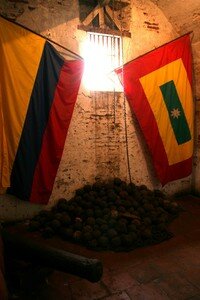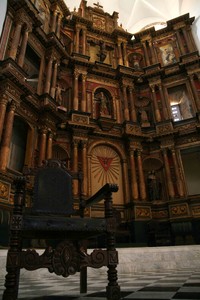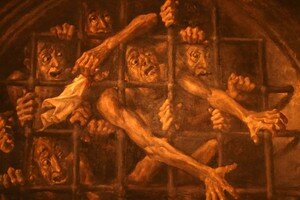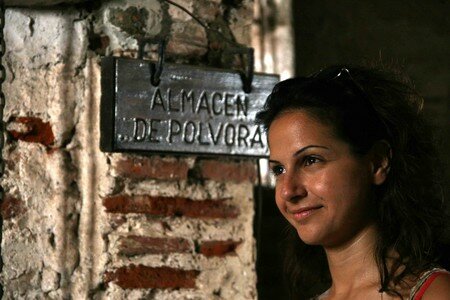Enjoying Cartagena
.
We start our day with the Castillo de San Felipe de Barajas, the greatest and strongest fortress ever built by the Spaniards in their colonies.  The original fort was constructed between 1639 and 1657 on top of the 40m high San Lazaro hill, and was quite small. In 1762, an extensive enlargement was undertaken, which resulted in the entire hill being covered over by this powerful bastion. It was truly impregnable and was never taken, despite numerous attempts to storm it. A complex system of tunnels connected strategic points of the fortress to distribute provisions and to facilitate evacuation. The tunnels were constructed in such a way that sounds reverberate all the way along them , making it possible to hear the slightest sound of the approaching enemy’s feet, and also making it easy for internal communication.
The original fort was constructed between 1639 and 1657 on top of the 40m high San Lazaro hill, and was quite small. In 1762, an extensive enlargement was undertaken, which resulted in the entire hill being covered over by this powerful bastion. It was truly impregnable and was never taken, despite numerous attempts to storm it. A complex system of tunnels connected strategic points of the fortress to distribute provisions and to facilitate evacuation. The tunnels were constructed in such a way that sounds reverberate all the way along them , making it possible to hear the slightest sound of the approaching enemy’s feet, and also making it easy for internal communication.
On the north side of the walled city stands the Plaza Las Bovedas, under whose arches, supplies and munitions were stored and troops lodged in colonial days. Today a busy crafts market functions here. We’re not too keen on such handicrafts and keep on wandering around.
 The Cathedral was begun in 1575 but in 1586, while still under construction, it was partially destroyed by the cannons of Francis Drake and not completed until 1612. Alterations were made between 1912 and 1923 by the archbishop of Cartagena, who covered the church with stucco and painted it to look like marble. He commissioned the dome on the tower. Recent restauration has ucovered the lively limestone on the building’s exterior. Apart from the tower’s top, the church has basically preserved the original form . It has fort-like appearance and a simply decorated interior with three naves and semicular archways supported on high stone columns. The main retable, worked in gold leaf, dates from the 18th century.
The Cathedral was begun in 1575 but in 1586, while still under construction, it was partially destroyed by the cannons of Francis Drake and not completed until 1612. Alterations were made between 1912 and 1923 by the archbishop of Cartagena, who covered the church with stucco and painted it to look like marble. He commissioned the dome on the tower. Recent restauration has ucovered the lively limestone on the building’s exterior. Apart from the tower’s top, the church has basically preserved the original form . It has fort-like appearance and a simply decorated interior with three naves and semicular archways supported on high stone columns. The main retable, worked in gold leaf, dates from the 18th century.
.
.
 The Palace of Inquisition is one of the finest buildings in town. Although the site was the seat of the Punishment Tribunal of the Holy Office from 1610, the palace wasn’t completed until 1776. It is a good example of late colonial architecture, noted particularly for its magnificent baroque stone gateway topped by the Spanish coat of arms, and the long balconies along the façade.
The Palace of Inquisition is one of the finest buildings in town. Although the site was the seat of the Punishment Tribunal of the Holy Office from 1610, the palace wasn’t completed until 1776. It is a good example of late colonial architecture, noted particularly for its magnificent baroque stone gateway topped by the Spanish coat of arms, and the long balconies along the façade.
On the side wall, there’s a small window with a cross o top. Heretics were denounced here, and the Holy Office would then investigate proceedings.  The principal ‘crimes’ were magic, witchcraft, and blasphemy. When culprits were found guilty, they were sentenced to death in a public auto-da-fe. Five auto-da-fe took place during the Inquisition until independence in 1821. About 800 people were condemned to death and executed. The Inquisition did not judge the Indians. The palace is today a museum which displays Inquisitors’ instruments of torture, pre-Colombian pottery ad historical objects dating from both colonial and Independence time, including arms, paintings, furniture and church bells.
The principal ‘crimes’ were magic, witchcraft, and blasphemy. When culprits were found guilty, they were sentenced to death in a public auto-da-fe. Five auto-da-fe took place during the Inquisition until independence in 1821. About 800 people were condemned to death and executed. The Inquisition did not judge the Indians. The palace is today a museum which displays Inquisitors’ instruments of torture, pre-Colombian pottery ad historical objects dating from both colonial and Independence time, including arms, paintings, furniture and church bells.
We end up this beautiful day watching a play. A theatre company presented an adaptation of the famous 100 years of Solitude, by Gabriel Garcia Marquez. Given our level of Spanish it certainly was useful we read the book beforehand! Lovely evening under the stars.




/http%3A%2F%2Fstorage.canalblog.com%2F46%2F38%2F88988%2F131192712_o.jpg)
/http%3A%2F%2Fstorage.canalblog.com%2F22%2F44%2F88988%2F14387025_o.jpg)
/http%3A%2F%2Fstorage.canalblog.com%2F31%2F16%2F88988%2F14386806_o.jpg)
/http%3A%2F%2Fstorage.canalblog.com%2F34%2F37%2F88988%2F14386318_o.jpg)
/https%3A%2F%2Fstorage.canalblog.com%2F68%2F13%2F88988%2F131346695_o.jpg)
/https%3A%2F%2Fstorage.canalblog.com%2F46%2F43%2F88988%2F47990981_o.jpg)
/https%3A%2F%2Fstorage.canalblog.com%2F34%2F23%2F88988%2F47957389_o.jpg)
/https%3A%2F%2Fstorage.canalblog.com%2F69%2F48%2F88988%2F47956242_o.jpg)
/https%3A%2F%2Fstorage.canalblog.com%2F71%2F12%2F88988%2F21063019_o.jpg)